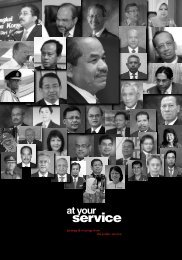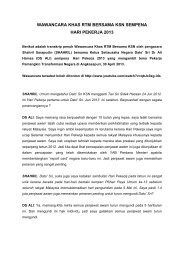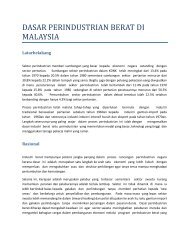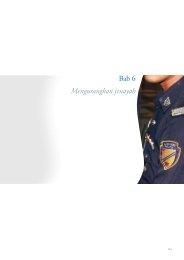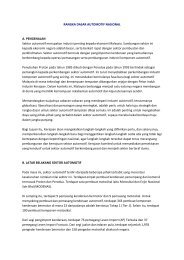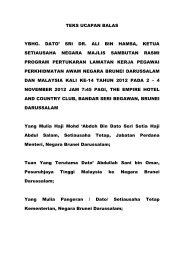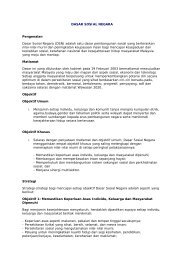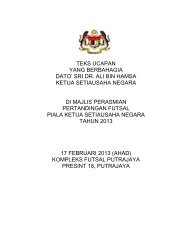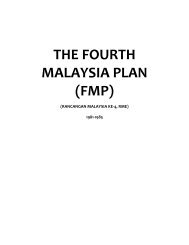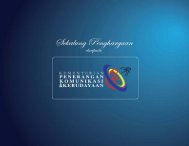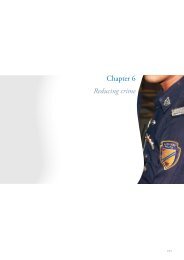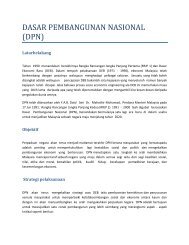GTP 2.0 - Prime Minister's Office of Malaysia
GTP 2.0 - Prime Minister's Office of Malaysia
GTP 2.0 - Prime Minister's Office of Malaysia
You also want an ePaper? Increase the reach of your titles
YUMPU automatically turns print PDFs into web optimized ePapers that Google loves.
INITIaTIvES<br />
9.1<br />
The UPT NKRA upgraded a total <strong>of</strong> 1,116<br />
bus stops in <strong>GTP</strong> 1.0 and began work on<br />
an additional 272 new bus stops within<br />
Greater KL in 2012.<br />
Although the UPT NKRA did not meet its modal<br />
share target <strong>of</strong> 25% in 2012, the 11 initiatives<br />
implemented in <strong>GTP</strong> 1.0 to improve the urban public<br />
transport system achieved show significant results in<br />
terms <strong>of</strong> adding capacity and improving accessibility<br />
and connectivity. The initiatives were grouped under<br />
four main categories <strong>of</strong> Bus, Rail, Integration and<br />
Network.<br />
bus<br />
The bus network remains an<br />
important mode <strong>of</strong> public transport<br />
for the rakyat, but congested roads<br />
as well as overlaps <strong>of</strong> routes have<br />
resulted in inefficiencies for the<br />
service. The Kuala Lumpur bus<br />
service also faces capacity issues<br />
in terms <strong>of</strong> equipment as well as a<br />
lack <strong>of</strong> qualified drivers.<br />
To rectify the issue, 470 new<br />
RapidKL buses were introduced<br />
in <strong>GTP</strong> 1.0, and four new Bus<br />
Expressway Transit (BET) routes<br />
were proposed. The UPT NKRA also<br />
took steps to upgrade supporting<br />
facilities such and created<br />
integrated transport terminals such<br />
as the one in Bandar Tasik Selatan.<br />
The UPT NKRA upgraded a<br />
total <strong>of</strong> 1,116 bus stops in <strong>GTP</strong> 1.0<br />
and began work on an additional<br />
272 new bus stops within Greater<br />
KL in 2012. It has also started<br />
implementing the Bus Expressway<br />
Transit (BET) and an initial two<br />
Go KL bus services (Green &<br />
Purple lines).<br />
RaIl<br />
The rail network into and out <strong>of</strong> the<br />
Kuala Lumpur City Centre remains<br />
the most important public transport<br />
route accounting for 40% <strong>of</strong> total<br />
public transport ridership. It is also<br />
the only mode <strong>of</strong> public transport<br />
that services satellite cities in<br />
any significant scale via the KTM<br />
Komuter trains.<br />
In 2012, the UPT NKRA<br />
gradually injected 37 KTM Komuter<br />
six-car train sets beginning<br />
in March, which significantly<br />
improved the capacity <strong>of</strong> the rail<br />
line. As a result, waiting times<br />
during AM peak hours reduced<br />
from 45 minutes to 15 minutes.<br />
Similar enhancements were also<br />
undertaken for Light Rail Transit<br />
(LRT) Kelana Jaya networks,<br />
generated significant increases in<br />
passenger capacity.<br />
The expansion <strong>of</strong> the LRT train<br />
route is also presently underway<br />
and estimated to be completed<br />
by the end <strong>of</strong> the 2nd quarter <strong>of</strong><br />
2015, extending service to satellite<br />
communities that are presently<br />
under served.<br />
In 2012, the UPT<br />
NKRA gradually<br />
injected 37 KTM<br />
Komuter six-car train<br />
sets beginning in March,<br />
which significantly<br />
improved the capacity<br />
<strong>of</strong> the rail line.<br />
172 Government transformation Programme—Annual Report 2012 Chapter Nine 173<br />
Government transformation Programme—Annual Report 2012 Chapter Nine




